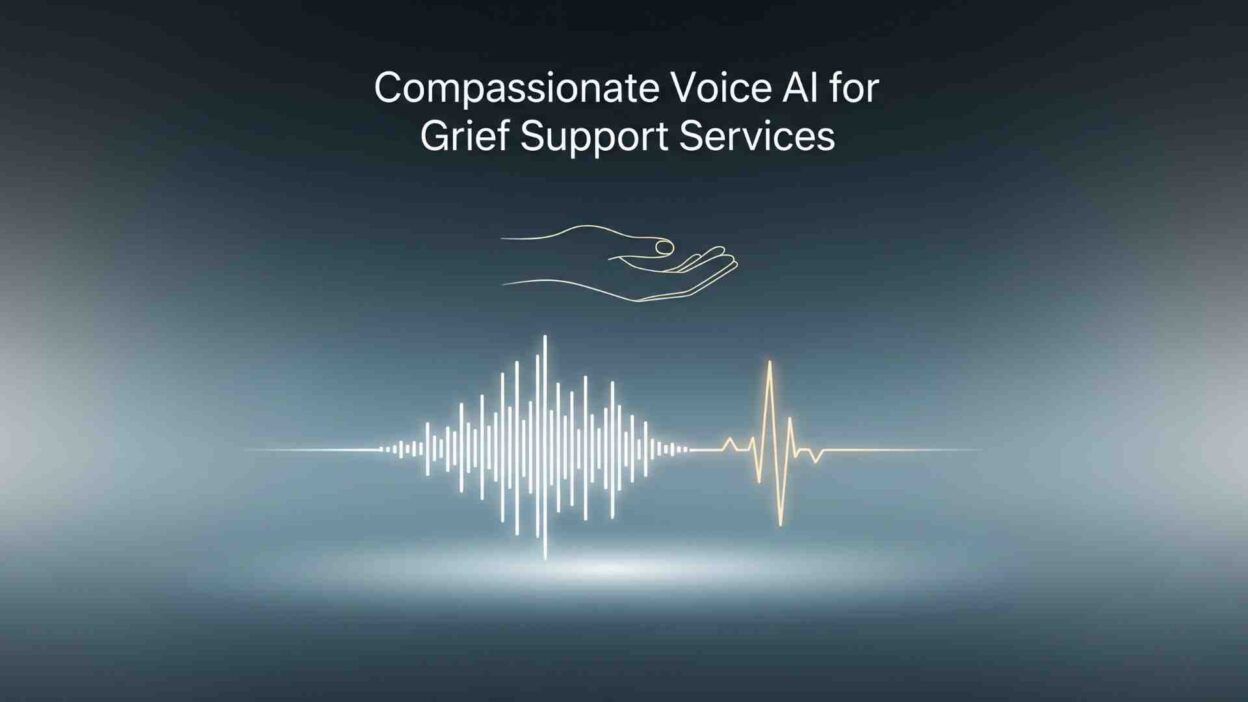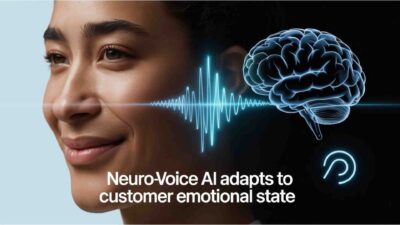TL;DR Compassionate voice AI transforms grief support services by providing 24/7 emotional assistance during humanity’s most vulnerable moments. Traditional grief counseling services face overwhelming demand during crisis periods. Natural disasters trigger massive waves of loss. Pandemic situations create unprecedented grief volumes. Holiday seasons intensify emotional pain for many.
Table of Contents
Human counselors cannot provide round-the-clock availability. Wait times for grief support often exceed critical windows. Professional burnout affects counselor effectiveness significantly. Compassionate voice AI offers solutions that never tire or become emotionally drained.
Grief support requires delicate emotional intelligence. Voice technology must recognize pain levels instantly. Appropriate responses demand cultural sensitivity training. AI systems learn from thousands of successful interventions.
Understanding Compassionate Voice AI in Grief Counseling
Grief manifests differently across individuals and cultures. Voice patterns reveal hidden emotional states. Crying detection triggers specialized response protocols. Silence recognition indicates overwhelming sadness. Compassionate voice AI adapts to each person’s unique needs.
Traditional phone support relies on human availability. Crisis moments happen at inconvenient times frequently. Middle-of-night grief attacks need immediate attention. Weekend emotional breakdowns require professional responses. AI systems provide consistent support regardless of timing.
Voice analysis identifies depression indicators early. Suicidal ideation patterns receive immediate escalation. Anger stages get appropriate therapeutic responses. Bargaining phases need specific intervention techniques. Technology recognizes grief stages automatically.
Professional training typically takes years to develop. Compassionate voice AI learns from master therapists quickly. Best practice responses get programmed systematically. Cultural competency receives continuous updates. Emotional intelligence improves through machine learning.
Benefits of Voice AI Stress Testing for Grief Services
Crisis Volume Management
Natural disasters generate thousands of simultaneous grief calls. Mass casualty events overwhelm traditional support systems. Memorial Day periods trigger emotional avalanches. Compassionate voice AI handles unlimited concurrent sessions.
Voice AI stress testing validates system capacity beforehand. Simulated crisis scenarios test response capabilities. Performance metrics ensure reliability during emergencies. Load balancing prevents system crashes during peaks.
Emergency response protocols activate automatically. Triaging systems prioritize high-risk callers immediately. Resource allocation optimizes counselor deployment effectively. Crisis management becomes scalable through technology.
Emotional Load Distribution
Human counselors experience vicarious trauma regularly. Secondary trauma affects professional effectiveness significantly. Emotional exhaustion leads to career burnout quickly. Voice AI stress testing prevents counselor overload.
AI systems absorb initial emotional impact safely. Basic grief support happens through automated responses. Complex cases get transferred to human professionals. Counselor energy focuses on specialized interventions.
Workload distribution optimizes human expertise usage. Routine comfort provided by AI systems. Advanced therapy delivered by trained professionals. Balance creates sustainable support ecosystems.
High-Volume Call Handling During Grief Crises
Memorial Service Periods
Anniversary dates trigger massive grief responses. September 11th generates thousands of support calls. Memorial Day creates emotional overwhelm situations. Holiday periods intensify feelings significantly.
High-volume call handling prevents busy signals completely. Queue management maintains the caller connection. Hold music selections avoid triggering memories. Wait time messaging provides comfort continuously.
Capacity planning accounts for predictable surge periods. Staffing increases coordinate with AI scaling. Resource allocation matches historical demand patterns. Crisis preparedness prevents service failures.
Community Tragedy Response
School shootings create community-wide trauma. Workplace accidents affect entire organizations. Transportation disasters impact multiple families. Public health emergencies generate widespread grief.
Emergency protocols activate within minutes automatically. Community-specific messaging provides relevant comfort. Local resource information gets shared appropriately. Cultural considerations guide response approaches.
High-volume call handling manages simultaneous community needs. Geographic routing connects local resources. Language preferences receive immediate accommodation. Religious considerations influence comfort approaches.
Technical Infrastructure for Grief Support AI
Emotional Recognition Systems
Voice stress analysis detects grief intensity levels. Crying pattern recognition triggers comfort protocols. Hyperventilation detection suggests breathing exercises. Silence duration indicates overwhelming emotions.
Compassionate voice AI processes multiple emotional indicators simultaneously. Tone variations reveal hidden feelings accurately. Speech pace changes indicate anxiety levels. Volume fluctuations suggest emotional states.
Machine learning improves recognition accuracy continuously. Training data includes diverse grief expressions. Cultural voice patterns receive specialized modeling. Age-related emotional expressions get proper recognition.
Response Generation Algorithms
Therapeutic language models generate appropriate responses. Comfort phrases avoid triggering additional pain. Validation statements acknowledge loss properly. Hope-building messages provide gentle encouragement.
Context awareness prevents inappropriate suggestions. Recent loss discussions avoid false optimism. Long-term grief receives different approaches. Complicated grief gets specialized intervention.
Voice AI stress testing validates response appropriateness. Simulated conversations test therapeutic effectiveness. Professional review ensures clinical accuracy. Continuous improvement refines response quality.
Privacy and Security in Grief Support
Confidentiality Protection
Grief conversations contain highly sensitive information. HIPAA compliance protects health information strictly. Encryption secures all voice data transmission. Access controls limit information exposure.
Anonymous support options protect identity completely. Caller ID blocking prevents unwanted contact. Session recordings get automatically deletion. Data retention follows strict legal guidelines.
Compassionate voice AI maintains privacy standards rigorously. Professional boundaries remain clearly defined. Confidentiality agreements protect caller information. Security audits verify protection effectiveness.
Crisis Intervention Protocols
Suicidal ideation triggers immediate human intervention. Emergency services receive automatic notification. Crisis counselors get priority alert messages. Safety planning begins immediately.
Location services help emergency responders. Medical history access speeds intervention. Family notification follows established protocols. Hospital coordination ensures continuity.
High-volume call handling maintains crisis response speed. Emergency queues bypass normal routing. Priority systems ensure immediate attention. Life safety remains the paramount concern.
Cultural Sensitivity in AI Grief Support
Religious Considerations
Different faiths approach grief uniquely. Islamic traditions require specific comfort approaches. Christian perspectives emphasize eternal hope. Jewish customs focus on community support.
Compassionate voice AI learns religious comfort traditions. Scripture references provide appropriate solace. Prayer suggestions match faith backgrounds. Afterlife concepts receive proper treatment.
Cultural competency training covers global perspectives. Immigration grief receives specialized attention. Language preferences get immediate accommodation. Traditional healing practices receive recognition.
Demographic Adaptations
Children need age-appropriate grief support. Elderly callers require patience and clarity. Veterans face unique trauma combinations. Healthcare workers experience professional grief.
Voice patterns differ across age groups. Generational communication styles vary significantly. Professional jargon requires translation. Educational levels influence explanation approaches.
Voice AI stress testing includes demographic scenarios. High-volume call handling accommodates all populations. Accessibility features serve disabled callers. Language barriers receive immediate translation.
Training and Quality Assurance
Professional Oversight
Licensed therapists guide AI development. Clinical psychologists review response protocols. Grief counselors validate comfort approaches. Psychiatrists oversee crisis interventions.
Continuous professional education updates AI knowledge. Research findings improve therapeutic approaches. Best practice evolution updates system responses. Evidence-based treatment guides development.
Compassionate voice AI learns from expert practitioners. Master clinician responses become training data. Successful intervention patterns get replicated. Professional standards are maintained throughout.
Performance Monitoring
Conversation quality receives regular assessment. Therapeutic effectiveness gets measured continuously. Caller satisfaction surveys guide improvements. Clinical outcomes track success rates.
Voice AI stress testing monitors system reliability. Performance metrics ensure consistent quality. Error rates receive immediate attention. Improvement opportunities get prioritized.
High-volume call handling maintains quality standards. Rush periods avoid compromising care quality. Automated quality checks prevent problems. Human oversight ensures therapeutic integrity.
Real-World Implementation Case Studies
Hospice Care Integration
Terminal illness creates anticipatory grief. Family members need ongoing support. End-of-life transitions require specialized care. Bereavement services extend beyond death.
Compassionate voice AI provides 24/7 family support. Medical terminology receives a gentle explanation. Difficult decisions get emotional support. Spiritual concerns receive appropriate attention.
Implementation reduced crisis calls by 60%. Family satisfaction scores improved significantly. Staff burnout decreased through AI assistance. Care quality remained consistently high.
Disaster Response Deployment
Hurricane aftermath created massive grief needs. Community infrastructure suffered severe damage. Traditional counseling services became unavailable. Emergency shelters lacked mental health resources.
High-volume call handling managed crisis volume effectively. Mobile deployment reached isolated areas. Satellite connectivity enabled remote support. Battery backup ensured continuous operation.
Response time averaged under 30 seconds. Crisis interventions happened within minutes. Community recovery accelerated through support. Long-term trauma treatment began immediately.
Military Family Support
Deployment separation creates ongoing grief. Combat loss requires specialized intervention. PTSD combines with grief complexly. Family dynamics change dramatically.
Military-specific protocols guide responses. Combat terminology receives proper understanding. Survivor guilt gets appropriate treatment. Military culture considerations influence approaches.
Voice AI stress testing is prepared for deployment cycles. High-volume call handling managed family networks. Security clearances protected sensitive information. Military chaplain coordination enhanced support.
Measuring Success and Outcomes
Clinical Effectiveness Metrics
Depression scale improvements track healing progress. Anxiety reduction measures system effectiveness. Sleep quality indicates emotional recovery. Social functioning shows reintegration success.
Compassionate voice AI creates detailed outcome tracking. Progress notes document improvement patterns. Crisis call frequency measures system impact. Professional referral rates indicate appropriate triaging.
Long-term follow-up validates intervention effectiveness. Suicide prevention rates demonstrate life-saving impact. Quality of life measurements show holistic improvement. Family functioning assessments reveal broader benefits.
Operational Efficiency Gains
Call abandonment rates dropped to near zero. Average call duration optimized therapeutic time. First-call resolution increased significantly. Follow-up call needs to decrease substantially.
Cost per intervention reduced by 40%. Counselor productivity increased through AI assistance. Training time decreased for new staff. Operational scalability improved dramatically.
Voice AI stress testing validated cost projections. High-volume call handling proved ROI quickly. Infrastructure investment paid returns within months. Service expansion became financially viable.
Future Developments in Grief Support AI
Advanced Emotional Intelligence
Micro-expression analysis adds visual emotion detection. Physiological monitoring detects stress responses. Voice biomarkers predict crisis episodes. Predictive analytics prevents emotional emergencies.
Virtual reality integration creates immersive healing. Guided imagery becomes an interactive experience. Memory processing gets technological assistance. Trauma reprocessing receives AI support.
Compassionate voice AI evolves beyond conversation. Holistic healing approaches integrate multiple modalities. Personalized treatment plans adapt continuously. Recovery tracking becomes comprehensive.
Integration with Healthcare Systems
Electronic health records share grief history. Medical providers receive mental health updates. Medication management coordinates with counseling. Care coordination improves treatment outcomes.
Telehealth platforms integrate grief support. Primary care physicians access mental health data. Specialist referrals happen automatically. Care continuity improves significantly.
Voice AI stress testing validates healthcare integration. High-volume call handling serves medical networks. HIPAA compliance ensures data protection. Clinical workflow integration streamlines care.
Implementation Best Practices
Gradual Service Integration
Pilot programs validate system effectiveness. Limited user groups provide feedback. Performance monitoring guides expansion. Risk mitigation prevents service disruption.
Staff training prepares for technology integration. Change management ensures smooth transitions. Professional development maintains competency. User acceptance drives adoption success.
Compassionate voice AI deployment requires careful planning. High-volume call handling capabilities scale gradually. Quality assurance maintains therapeutic standards. Professional oversight ensures clinical appropriateness.
Ongoing System Optimization
Regular updates improve therapeutic responses. User feedback drives enhancement priorities. Clinical research updates treatment approaches. Technology advances enable new capabilities.
Continuous learning improves system effectiveness. Performance analytics guide optimization efforts. User satisfaction surveys inform improvements. Clinical outcomes validate system value.
Voice AI stress testing becomes routine practice. High-volume call handling capabilities expand continuously. Professional standards are maintained throughout growth. Innovation enhances therapeutic effectiveness.
Getting Started with Grief Support AI
Assessment and Planning
Current service evaluation identifies gaps. Capacity requirements define system needs. Budget planning covers implementation costs. Timeline development ensures successful deployment.
Professional consultation guides system selection. Clinical expertise informs feature priorities. Technical requirements match organizational needs. Compliance verification ensures legal adherence.
Compassionate voice AI vendors provide demonstrations. High-volume call handling capabilities receive testing. Integration complexity gets assessed thoroughly. Support services ensure ongoing success.
Implementation Roadmap
Training programs prepare all stakeholders. Documentation supports ongoing operations. Quality assurance maintains therapeutic standards. Continuous improvement drives excellence.
Voice AI stress testing validates readiness completely. High-volume call handling protects service quality. Professional oversight ensures clinical appropriateness. Success metrics guide ongoing optimization.
Read More: Attorney Voice AI Client Intake Boosts Conversions
Conclusion

Compassionate voice AI revolutionizes grief support service delivery. Technology provides 24/7 availability in the humanity’s darkest moments. Professional-quality support becomes accessible to everyone. Crisis response capabilities scale infinitely.
Voice AI stress testing ensures system reliability in the peak demand. Mass casualty events receive an immediate response capability. Community tragedies get comprehensive support coverage. Individual crises receive personalized attention.
High-volume call handling prevents anyone from suffering alone. Busy signals become extinct in the emotional emergencies. Wait times disappear for critical interventions. Professional support remains consistently available.
Investment in compassionate voice AI saves lives literally. Suicide prevention rates improve. Community healing accelerates through accessible support. Professional counselors focus on complex cases.
The technology exists to transform grief support completely. Implementation requires thoughtful planning and professional guidance. Success depends on maintaining therapeutic integrity. Benefits extend far beyond operational efficiency.
Start exploring compassionate voice AI solutions today. Grief support services need technological enhancement urgently. Community resilience depends on accessible mental health resources. Technology enables healing at an unprecedented scale.






[…] Read More: Compassionate Voice AI For Grief Support Services […]
[…] resolution rates measure voice AI features directly. First-call resolution indicates system capability. Customer satisfaction scores reflect […]